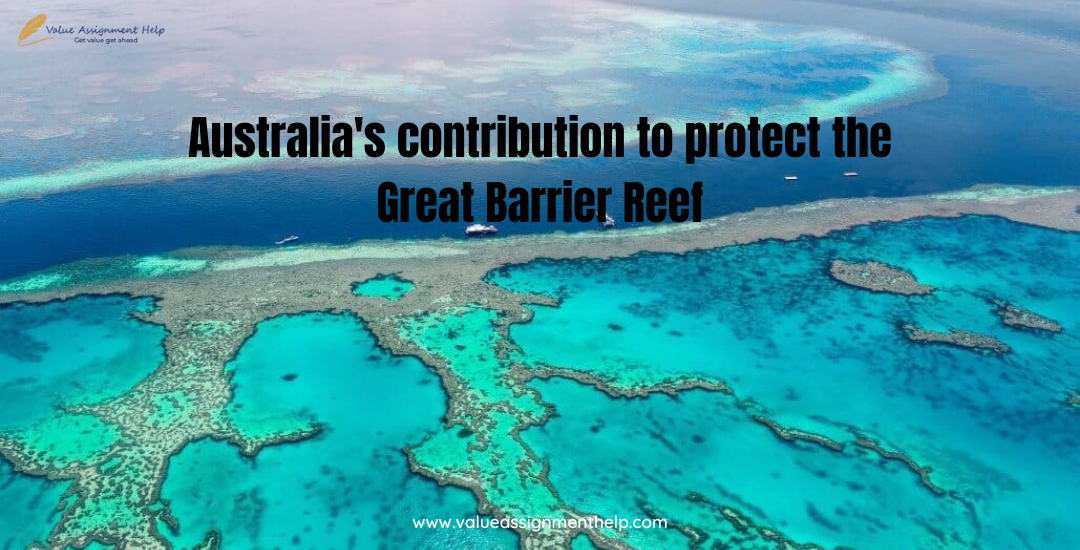
Search Assignments
Table of Contents
Our Experts

Search Assignments

Customers Reviews
Recently, the news of the great barrier reef suggested as "being in danger" has come up. The news came to light after the release of the joint report presented by the International Union for Conservation of Nature (IUCN) and UNESCO's World Heritage Centre (WHC) on the 29th of November this year. Similar suggestions were made last year, but after lobbying from the Government, the decision was postponed to this year.

The report suggests that the excellent Barrier reef be put on the list of "World heritage sites in danger" after "declining health of the ecosystem" and "' too frequent bleaching". In counteraction, the Government of Australia soon after released a report citing the new fund of A$1.2 dedicated explicitly to improving the excellent barrier reef system of the nation.
( Sample assignment help from VAH experts on how to write a report on present scenarios)
The coral reefs worldwide have drastically changed in the past decade due to rising global temperatures and heated water bodies.
In the 2016 heat wave, one-third of excellent barrier reef died as per the "Nature" journal, and as per the research done by UNESCO in mid-march, the health of the coral ecosystem is briskly declining. Frequent bleaching phenomenon concerns environmentalists and scientists in which coral reef loses their brightly coloured algae covering and leaves behind a greyish-white skeleton. The reef in this condition is alive, but the prolonged loss of its algae covering might lead to its death.
The phenomenon helps in keeping the reef cool and occurs during heated temperatures.
However, what is alarming about the situation is that this self-occurring phenomenon has occurred four times in the past seven years, which is too frequent to scientists. One-time bleaching occurred during "La Ninncredible wave of water originating in the equatorial Pacific, resuresultinger temperatures. Bleaching occurring even during La Nina explains the grave concern of scientists.
But bleaching is not the only thing. For example, a global rise of 1.5 degrees Celsius might mean losing 70-90% of the coral reefs globally. Furthermore, a rise from 1.5 to 2 degrees Celsius will lead to the wiping off of 99% of the biodiversity.
Whenever you watch any underwater photo or video, you might see bright grass-like structures, as depicted in the image; they are called coral reefs. Found in shallow waters, they are formed by cumulative piling coral polyps (corals that make up a reef) releasing calcium over many years, leading to hard calcium deposits around low-water areas in coastal regions called coral reefs. Over a period, even plant and fish body deposits help form the reef. The system shelters 2,900 individual reefs across 900 islands, covering an area of approximately 344,400 square kilometres.
Apart from being home to more than 2900 species, the reef is a source of nutrition for various underwater species. It is covered with algae, responsible for its bright and unique colours. Bright colour makes them attractive and even pleasing to look at. This is why more than 70 million tourists visit and experience this underwater life support system.
Known as "tropical forests of oceans", like trees on the land, corals absorb carbon from seawater, help prevent coastal erosion, provide fish and livestock for humans and attract tourists worldwide.
GBR is a marine powerhouse of Australia and, pre-COVID contributed more than 6 Billion Dollars each year and provided around 64,000 full-time jobs. So, as per ocean wealth, coral reef accounts for Billions of dollars in business per year, and around 1 billion people worldwide depend on coral reefs directly or indirectly.
Wildly popular in medicine, the reef also serves medicinal benefits in research on Cancer treatment.
( A detailed analysis highlighting the assignment conditions for HD grade. Value assignment help with its worldwide presence has contributed to the success of numerous college homework)
Australia, a tropical continent home to cute Kolas, lush rainforests and beautiful beaches, is also famous for its great barrier reef system, which is, by the way. Largest reef ecosystem in the world. Australia is of keen interest here because although there are various reef systems, such as Cuba, Jamaica, and the Bahamas, Australia houses the largest of them and more than a million Australian Citicitizens depend on them.
themThe excellent barrier reef was included in the list of world heritage sites in 1981, considering its unique natural ecosystem and scientific benefits. Since then, it has been on the list until last year, when UNESCO proposed considering it a world heritage site in danger. The step was to facilitate additional support for the protection and conservation of (GBR) including releasing monetary funds on priority basics and gaining international support.
However, the government opposed the move. The same danger threatens all coral reefs worldwide. It does not see how putting the reef on a "danger list" would help. Hence, GBR shall not be considered in the list. As per critics, the move has put forward the thought that the UNESCO suggestion, if implemented, might reflect poorly on the tourism and livelihood of the people dependent on it. "It would scare away the tourists", another news article published in Reuters said.
To protect and manage the system, the Government, in conjunction with UNESCO and IUCN, has been rigorously working for its preservation.
For starters, the management and protection of the system have been undertaken by the Great Barrier Reef Marine Park Authority, formed under "The Great Barrier Reef Marine Park Act 1975". As per the citing of UNESCO, to maintain the integrity of the barrier reef system, the entire ecosystem has been merged as one park, "the Great Barrier Reef Coast Marine Park", which has been formed under Marine Parks Act 2004. Queensland is responsible for managing the Great Barrier Reef Coast Marine Park, which comprises 99% of the property.
Furthermore, four crucial policies have been implemented by the Government of Australia and Queensland, including the latest "The Reef 2050 Long-Term Sustainability Plan", released in 2015 and is still under public consideration. The plan outlines the vision to ensure that GBR is still seen as the "natural wonder" for our generations from now to mid-millennia. However, Jodie Rummer, a marine biologist at James Cook University, thinks we do not have until then to save GBR. In her opinionated blog published in The Sunday Morning Herald, she expresses her concern about the dying marine life and losing the heritage of this fantastic world wonder.
The new Government believes that the coral reef system is "already one of the best-managed reef systems globally", the Australian government website wrote. Therefore, per the Department of Climate change, Energy, the environment and Water of the Government of Australia, the Government will allocate a dedicated fund of A$1.2 billion for the conservation, cleaning and protection of Coral life from 2022 to 2030. So far, the nation has invested more than $4.4 billion in the cause.
Water contamination is one of the major causes of diseases among aquatic life. A study published by NPR stated that the chances of disease increase by 4-89% when they are in direct contact with plastic and marine pollution. Moreover, in a research paper published in April 2021 by Marine Pollution Bulletin, more than half of the marine pollution and threat to Global heritage sites has been caused by gullies. Gullies are the pathway formed by water bodies as they move. It looks more like giant piles of soil carved steeply by the water flow; these gullies deposit large sediments into water bodies. As per the report of UNESCO, the repair and maintenance of gullies are one of the top recommendations. In favour of the report, an article published by Andrew Brooks and James Daley revealed that more than 4,00,000 truck dumps of sediment are deposited each year into the Barrier. The article states that the best way to improve marine biodiversity's health is by stabilising gullies' health via mine site rehabilitation, which reshapes the gullies.
Considering ever-rising global carbon emissions and rising temperatures due to global warming, which adversely impact the life of coral reefs, many aviation companies have initiated investments in sustainable aviation fuel (SAF). For example, in mid-summer, this year, Qantas and Air Bus jointly planned to invest about $200 million in Australia to build its sustainable fuel industry. Furthermore, travel agents and fuel producers are offering customers to buy SAF, which will not be linked to individual flights. Australia Post, a partner of Qantas, said that it would use credit to reduce its carbon emission generated from air freight.
Like many other G20 members, Australia is also dedicated to achieving zero carbon emission by mid- millennia and capping the global temperature rise at 1.5 degrees Celsius. As per the press release by Government in September this year, the Government has achieved 43% of the target and passed the "Climate change bill" to achieve a 100% reduction in carbon emissions by 2050.
The subsidy cost for fossil fuels in Australia cost the Federal Government a whopping 11.6 Billion Dollars in 2021-22, an increase from $1.3 Billion last year, as per research by the Australia Institute research.
In another research, it was evident that Australia's total per capita coal emission is 4.04 tons, nearly four times the global average. As per Thinktank Ember, Australia is the second most coal-dependent nation after Poland for meeting its high energy demand. The country also has the highest greenhouse emissions due to coal energy generation in 2021. As per previous reports by the same company, the coal emission for Australia was an average of 5.34 tons from 2015 to 2020.




No Comments